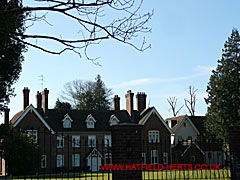 Airspeed – Hatfield footnotes
Airspeed – Hatfield footnotes
Apart from Airspeed, created by former de Havilland employees, being eventually taken over by the DHAC, Hatfield built well over 1,000 Airspeed aircraft and featured in that company's story in other ways. A building in which Airspeed's most famous design was built was moved to Hatfield, and is still standing (but has been changed and put to a very different use).
Airspeed AS.10 Oxford (L4534) – having made its first flight on 19 June 1937, its first public appearance was in the New Types Park at the 18th RAF Display at Hendon on 26 June 1937. Its second appearance was at the SBAC (Society of British Aircraft Constructors – later, Society of British Aerospace Companies) Show at Hatfield (28-29 June 1937), where it is clear that it was actually part of the flying display.
Later, de Havillands were chosen as subcontractors for producing Oxfords. In total 1,440 examples were made in Hatfield (although one source gives a higher total) before production was concentrated on the DH.98 Mosquito.
Amy Johnson – the famous female aviator was reportedly one of the original Airspeed investors in 1931. She was on the strength of the all female Air Transport Auxiliary unit based at Hatfield during the war. In January 1941 she set off on what were to be her final flights to deliver an Airspeed Oxford Mk II from Hatfield to Prestwick and to return a similar aircraft (V3540) to Kidlington, in Oxford. On her return flight, under still disputed circumstances, she bailed out over the Thames. Attempts to rescue her were unsuccessful. Her body was never found. Fragments of wreckage from V3540 were recovered.
AS.14 Ambassador – the original Airspeed Ambassador was a twin-engine high-wing monoplane, which resembled the DH.95 Flamingo but with a single rudder. Information about it was made available at the 1936 SBAC display at Hatfield. However, as it failed to secure any orders, it did not go into production.
AS.49 – single engine, single-seater fighter powered by a Gipsy VI created by the Airspeed design office when it was based at Hatfield. Unfortunately, the mock-up, drawings and design calculations were destroyed by a bombing raid on 2 October 1940. The Airspeed design team were moved to Salisbury Hall, where they worked on developing the AS.51 Horsa glider.
Airspeed AS.65 Consul – Civilian conversion of the AS.10 Oxford. The first Consul (G-AGVY) was a conversion of a Hatfield-built Oxford (V3679). Certified in March 1946 it was sold to the Bata Shoe Company.
Horsa Hangar – one of the buildings erected at Salisbury Hall during WWII. As the name suggests it was the building where the AS.51 Horsa prototypes were built. It was later disassembled and brought to Hatfield (not the first time a DH building has travelled about), where it was put up again on the Astwick Manor site (shown in the photo above) and became part of the de Havilland Aeronautical Technical School. The hangar was converted into 26 apartments (No. 13 to 38) and is now called De Havilland House.
R E Clear – Ronald Edward Clear was born in 1917 at Portsmouth. He got his ground engineer and pilot's licences at the age of 17 in1934. Airspeed test pilot from the late Thirties, and a close friend of George Errington. Later worked as a test pilot for de Havilland. He retired from test flying in 1980 to become Hatfield Aerodrome Manager for British Aerospace.
Trident tragedy – Sadly, in June 1966, Airspeed's former Chief Test Pilot George Errington, this time flying as second officer with three others, took off on his final flight from Hatfield in a HS.121 Trident (originally DH.121) G-ARPY. The aircraft went into a superstall and crashed killing all on board.